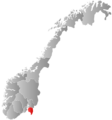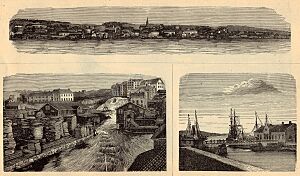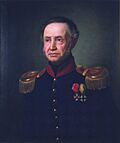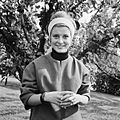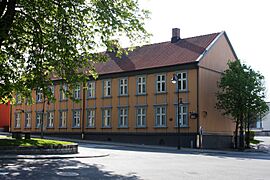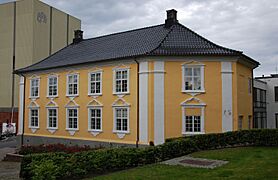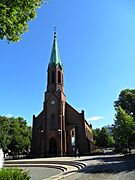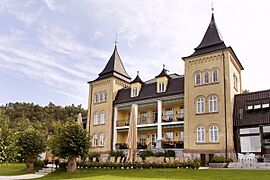Moss, Norway facts for kids
Quick facts for kids
Moss kommune
|
|||||
|---|---|---|---|---|---|
|
Municipality
|
|||||
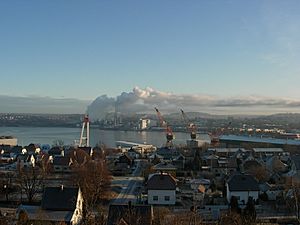
Moss seen from Jeløya
|
|||||
|
|||||

Moss within Østfold
|
|||||
| Country | Norway | ||||
| County | Østfold | ||||
| Administrative centre | Moss | ||||
| Area | |||||
| • Total | 63 km2 (24 sq mi) | ||||
| • Land | 58 km2 (22 sq mi) | ||||
| Area rank | #414 in Norway | ||||
| Population
(2021)
|
|||||
| • Total | 49 668 | ||||
| • Rank | #27 in Norway | ||||
| • Density | 440/km2 (1,100/sq mi) | ||||
| • Change (10 years) | 10.6% | ||||
| Demonym(s) | Mossing | ||||
| Time zone | UTC+01:00 (CET) | ||||
| • Summer (DST) | UTC+02:00 (CEST) | ||||
| ISO 3166 code | NO-3103 | ||||
| Official language form | Neutral | ||||
| Website | |||||
|
|
|||||
Moss is a town and a municipality located on the coast in Østfold county, Norway. It's an important center for the region. The town of Moss is the main administrative center for the municipality.
Moss became a municipality on January 1, 1838. It was recognized as a city much earlier, in 1720. Over time, other areas joined Moss. The rural area of Jeløy became part of the city in 1943. More recently, the former municipality of Rygge joined Moss on January 1, 2020.
The area managed by Moss includes places east of the town. This includes the island of Dillingøy in the lake Vansjø. Part of the town itself is located on the peninsula of Jeløy. In 2012, the city of Moss had 30,723 people living there.
Contents
What's in a Name?
The name Moss comes from an old Norse word, Mors. This word might mean "to divide" or "to split."
Other nearby places have names that sound similar:
- Mosse-elva is a river. Its name might mean "marsh-river-border." The meaning of this old name is not fully clear.
- Mosse-sundet is a channel. This name also includes "marsh-river-border."
- Mosse-herred means "Moss county." The word herred is an old term for a court or enclosed area.
A Look Back in Time: History of Moss
People have lived in the Moss area for a very long time. Archeologists have found signs of settlements from over 7,000 years ago. People continued to live here through the Iron Age and Viking Age, right up to today. During the Viking times, the place was called Varna. This name meant "protection" in Old Norse. It was a meeting spot where local leaders gathered warships for the king.
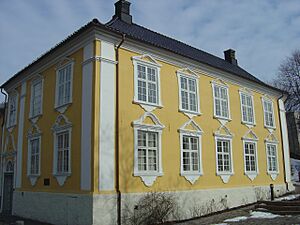
The name Mo(u)ſs(ß) first appeared in writing in 1396. By then, Moss was a busy place with traders, craftspeople, and mills. In the 1500s, the port of Moss was so important that it had its own customs official. Making liquor was a big industry. It wasn't until 1607 that the town got its own church.
By 1700, Moss was a key stop for ships and land travelers between Copenhagen and Oslo (then called Christiania). In 1704, the Moss Jernverk (Moss Ironworks) was built just north of the town center. In 1720, Moss officially became a merchant town with its own official. This might have been because of an important battle in 1716. Norwegian soldiers, led by Vincent Budde, won against Swedish forces in the town square. The Swedes, led by Charles XII, were trying to capture Akershus Fortress. In 1767, a local person built a beautiful "pleasure pavilion" nearby. Today, this building is the Hotel Refsnes Gods.
A very important event happened in Moss in 1814. The Convention of Moss was signed here. This agreement ended the union between Denmark and Norway. It also helped set the stage for Norway's future and led to a lot of economic growth that continues today.
Something exciting happened on July 14, 2006. A bright meteor, called a bolide, exploded over the nearby town of Rygge. Moments later, several stony meteorites fell over Moss. Many local people and meteorite hunters found these space rocks. Scientists studied them and found they were a rare type of carbonaceous chondrite.
City Symbols: Seal and Coat-of-Arms
Moss became a separate city in 1786 and got its first official seal that same year. This seal showed a church under some clouds, inside a circle. Above the circle were fasces, a symbol of freedom. A later seal from around 1829 showed the same picture, but with six birds flying around the church.
In the 1930s, the city wanted to create a coat-of-arms. The birds were considered as a symbol. The first birds were probably doves, which represent peace. But in 1934, the idea of using a crow came up. People from Moss have often been called "crows." There's an old story about a fire that started when lightning hit a bird's nest in the church spire. Many birds, thought to be crows, swarmed around the spire. The fire was put out quickly. Because of this story, birds became a symbol for the city.
The official coat-of-arms for Moss was approved on April 2, 1954. It shows a yellow crow on a red background. Christian Stenersen designed it.
The Norwegian Lady Statues
Moss and Virginia Beach, Virginia in the United States are sister cities. This means they have a special friendly relationship. Their connection comes from a sad event. On March 27, 1891, a Norwegian ship called the Dictator, which was from Moss, was lost in a dangerous area of the sea known as the "Graveyard of the Atlantic."
The ship was carrying lumber to England but got caught in a storm. It was heading to Virginia for repairs when another storm hit. Lifesaving crews from the shore managed to save some of the 17 people on board. However, the captain's pregnant wife, Johanne, and their 4-year-old son Carl were among the 7 people who drowned.
The ship's wooden figurehead (a carved figure on the front of a ship) washed ashore. It was placed upright on the beach, facing the ocean, as a memorial to those who died. It was a famous landmark for over 60 years. But over time, it became worn out by the weather.
In 1962, the City of Moss asked a Norwegian sculptor named Ørnulf Bast to make two large bronze copies of the original figurehead. These Norwegian Lady Statues were revealed on September 22, 1962. One was given as a gift to Virginia Beach. An exact copy was put up in Moss. This was done to connect the two sister cities. Each statue looks like it's facing the other across the Atlantic Ocean.
On October 13, 1995, Queen Sonja of Norway visited the Norwegian Lady statue in Virginia Beach. She placed memorial flowers there.
Where is Moss? Geography
Moss is located on the eastern side of the Oslofjord. This is a long, narrow inlet of the sea. Moss is about 60 kilometers (37 miles) south of Oslo, Norway's capital. The municipality also includes some islands, like Jeløya.
A special geological ridge called the Raet runs through the municipality. The area around Moss is mostly forested lowland. The highest point in Moss is 140 meters (459 feet) above sea level. Most of the people (84%) live in the town of Moss itself.
Weather in Moss: Climate
Moss has a climate that can be described as a humid continental climate. This means it has warm summers and cold winters.
The weather station at Moss Airport Rygge (40 meters above sea level) has been recording temperatures since 1955. The highest temperature ever recorded was 34.2°C (93.6°F) in August 1982. The lowest temperature was -31.5°C (-24.7°F) in February 1985. Many of the record low temperatures happened before 1990. The airport is further inland, so it can be colder in winter and autumn than in the town itself. On average, the first time the temperature drops below 0°C (32°F) in autumn at Rygge is around October 7.
| Climate data for Moss Airport, Rygge 1991-2020 (40 m, precipitation days 1961-90, extremes 1955-2020, sunhrs from Oslo) | |||||||||||||
|---|---|---|---|---|---|---|---|---|---|---|---|---|---|
| Month | Jan | Feb | Mar | Apr | May | Jun | Jul | Aug | Sep | Oct | Nov | Dec | Year |
| Record high °C (°F) | 11.2 (52.2) |
13.5 (56.3) |
21 (70) |
24.9 (76.8) |
30 (86) |
31.2 (88.2) |
33.9 (93.0) |
34.2 (93.6) |
25 (77) |
20 (68) |
16.7 (62.1) |
13.2 (55.8) |
34.2 (93.6) |
| Mean daily maximum °C (°F) | 0 (32) |
1 (34) |
5 (41) |
11 (52) |
16 (61) |
20 (68) |
22 (72) |
20 (68) |
17 (63) |
10 (50) |
5 (41) |
2 (36) |
11 (52) |
| Daily mean °C (°F) | −1.7 (28.9) |
−1.5 (29.3) |
1.3 (34.3) |
5.9 (42.6) |
11 (52) |
14.8 (58.6) |
17.2 (63.0) |
16.3 (61.3) |
12.3 (54.1) |
7.2 (45.0) |
2.9 (37.2) |
−0.6 (30.9) |
7.1 (44.8) |
| Mean daily minimum °C (°F) | −4 (25) |
−4 (25) |
−2 (28) |
2 (36) |
7 (45) |
11 (52) |
13 (55) |
12 (54) |
9 (48) |
5 (41) |
1 (34) |
−2 (28) |
4 (39) |
| Record low °C (°F) | −27.7 (−17.9) |
−31.5 (−24.7) |
−28.4 (−19.1) |
−11.6 (11.1) |
−4.9 (23.2) |
−0.3 (31.5) |
3.6 (38.5) |
0.7 (33.3) |
−5.1 (22.8) |
−9.7 (14.5) |
−19.5 (−3.1) |
−26.5 (−15.7) |
−31.5 (−24.7) |
| Average precipitation mm (inches) | 67 (2.6) |
52 (2.0) |
49 (1.9) |
50 (2.0) |
54 (2.1) |
76 (3.0) |
76 (3.0) |
96 (3.8) |
88 (3.5) |
110 (4.3) |
98 (3.9) |
78 (3.1) |
894 (35.2) |
| Average precipitation days (≥ 1.0 mm) | 10 | 7 | 9 | 7 | 8 | 9 | 9 | 10 | 11 | 12 | 12 | 9 | 113 |
| Mean monthly sunshine hours | 45.1 | 77.6 | 146.5 | 182.0 | 248.0 | 230.3 | 244.1 | 203.8 | 150.1 | 94 | 50.9 | 40.0 | 1,712.4 |
| Source 1: eklima.no/met.no (mean, precipitation, extremes) | |||||||||||||
| Source 2: weatheronline (avg high/low temperature) | |||||||||||||
What Moss Makes: Industry
Moss is known for its many factories. These include paper mills, which make paper products. There are also metalworks factories and other types of manufacturing plants.
Dillingøy, an island in the municipality, is known as a place for alternative non-military civil service. This is where people can do public service instead of military service.
Moss has been important for industry since the Renaissance. It was also the place where the Convention of Moss was signed in 1814, which helped create a union with Sweden.
The company Helly Hansen, which makes outdoor clothing, had its main office in Moss until 2009. Trio Ving, a company that makes keycards for hotels around the world, also has its headquarters here. Another company, AquaFence, which makes temporary barriers to protect against floods and hurricanes, is also based in Moss.
Getting Around: Transport
The Østfold Line railway runs through Moss. Trains stop at Moss Station. This station is the end point for one of the local train services to Oslo. It's also a stop for bigger regional trains.
You can travel across the Oslofjord from Moss to Horten using the Moss–Horten Ferry. There are also bus lines that connect Moss to places like Oslo Airport, Gardermoen, Gothenburg in Sweden, Copenhagen in Denmark, and Oslo. Of course, there are also local bus lines within Moss.
The port of Moss is very busy. It is one of the top 3 busiest container ports in Norway. This means many goods are shipped in and out of Moss by sea.
Fun and Games: Sport
Moss FK is the town's main football (soccer) club. They play in the Norwegian First Division. They even played in Norway's top league, the Norwegian Premier League, as recently as 2002.
Famous Faces from Moss
People from Moss are often called "Mossinger" by locals. Here are some notable people who have connections to Moss:
- Ari Behn (1972–2019), an author and playwright. He was raised in Moss and was once married to Princess Märtha Louise of Norway.
- Tina Bru (born 1986 in Moss), a politician and government minister.
- Palle Rømer Fleischer (1781 in Moss – 1851), who was a representative at the Norwegian Constitutional Assembly.
- Gregers Gram (1846 in Moss – 1929), who served as the Norwegian prime minister in Stockholm from 1889 to 1891.
- Christopher Hansteen (1822 in Moss – 1912), a judge who was an associate justice on the Supreme Court of Norway from 1867 to 1905.
- Eyvind Hellstrøm (born 1948 in Moss), a famous gourmet chef and TV personality.
- Knut Jacobsen (1910–1971), an actor and costume designer.
- Gretha Kant (born 1945), a politician who was the mayor of Moss from 1995 to 2003.
- Jorunn Kristiansen, who was crowned Miss Norway in 1959.
- David Menkin (born 1977 in Moss), an actor known for his work in film, TV, and voice acting.
- Jon Michelet (1944 in Moss – 2018), a novelist who wrote crime novels, newspaper columns, and children's books.
- Grynet Molvig (born 1942 in Rygge), a Norwegian actress and singer.
- Hanna Paulsberg (born 1987 in Rygge), a jazz musician who plays the tenor saxophone and composes music.
- Johan Scharffenberg (1869 in Moss – 1965), a psychiatrist, politician, speaker, and writer.
- Per Schwenzen (1899 in Moss – 1984), a writer of screenplays and librettos for operettas.
- Arild Sibbern (1785 in Rygge – 1863), a representative at the Norwegian Constituent Assembly.
- Georg Sibbern (1816 in Rygge – 1901), who was the prime minister of Norway during two periods: 1858-1861 and 1861-1871.
- Torgrim Sørnes (born 1956 in Moss), a physician, historian, and author.
Sports Stars
- Einar Jan Aas (born 1955 in Moss), a former football player who played 35 games for the Norwegian national team.
- Agnete Carlsen (born 1971 in Moss), a former football player who played 97 games for the Norwegian women's national team.
- Erik Holtan (born 1969 in Moss), a retired football goalkeeper who played over 330 club games.
- Rune Pedersen (born 1963 in Moss), a former football referee.
- Thomas Myhre (born 1973, grew up in Moss), a retired football goalkeeper who played 56 games for the Norwegian national team.
- Erland Johnsen (born 1967, grew up in Moss), a retired football player who played 24 games for the Norwegian national team.
Friends Around the World: Twin Cities
Moss has "twin towns" or "sister cities" around the world. This means they have special partnerships to promote cultural ties and understanding.
The following cities are twinned with Moss:
 Aguacatán, Guatemala
Aguacatán, Guatemala Blönduós, Iceland
Blönduós, Iceland Horsens, Denmark
Horsens, Denmark Karlstad, Sweden
Karlstad, Sweden Nokia, Finland
Nokia, Finland Novgorod, Russia
Novgorod, Russia Virginia Beach, Virginia, United States
Virginia Beach, Virginia, United States
Gallery
See also
 In Spanish: Moss para niños
In Spanish: Moss para niños




